Mary Lydon Simonsen's Blog: What readers are saying about The Second Date, page 2
February 12, 2014
Guest Post by J. Marie Croft and Giveaway of Love at First Slight
Here’s to romance, laughter, and happily ever after!
By J. Marie Croft
It was once suggested in a letter to Jane Austen that she write “an historical romance illustrative of the august House of Cobourg. ”Austen’s response included: “I could no more write a romance than an epic poem. I could not sit seriously down to write a serious romance under any other motive than to save my life; and if it were indispensable for me to keep it up and never relax into laughing at myself or at other people, I am sure I should be hung before I had finished the first chapter.” I get a bit hung up telling people that I write what’s considered romance, because it’s inevitably presumed I mean bodice-rippers. Eesh! I could no more sit seriously down to write a steamy novel than an epic poem. I regard Love at First Slightas a Regency romantic comedy. Snippet from favourable review: “While Love at First Slight is mostly a comedy, one mustn't forget the romance, which was just beautifully done from start to finish.” Another critic said, “If there is a romance, I did not find it.” Readers obviously have decidedly different opinions on what constitutes romance.
According to Wikipedia: • Romances are relationship stories that emphasize emotion over libido. • Regency romancesfeature intelligent, fast-paced dialogue between the protagonists and very little explicit sex or discussion of it. • Romantic comediesfocus on sentimental ideals in humorous plots. In a typical ‘rom-com’ the young, likable lovers are meant for each other but kept apart by complicating circumstances (class differences, family interference, etc.) until finally – surmounting all obstacles – they get together with a fairytale-style ending.Love at First Slight is a Regency romantic comedy. That’s my story, and I’m sticking to it.
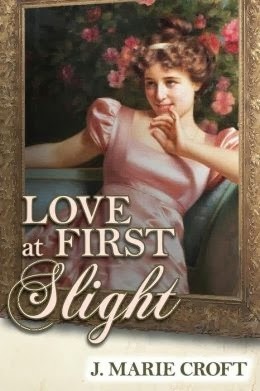
Here is the blurb from Amazon for Love at First Slight :
It may not be universally acknowledged, but the unvarnished truth is that a young widow in possession of a good fortune is not necessarily in want of another husband.
In this humorous, topsy-turvy Pride & Prejudice variation, all major gender roles are reversed. It is Mr. Bennet’s greatest wish to see his five sons advantageously married. When the haughty Miss Elizabeth Darcy comes to Netherfield with the Widow Devonport (nee Bingley), speculation — and prejudice — runs rampant.
William Bennet, a reluctant and irreverent reverend, catches Miss Darcy’s eye, even though he is beneath her station. His opinion of her is fixed when she slights him at the Meryton assembly. As her ardour grows, so does his disdain. When she fully expects to receive an offer of marriage, he gives her something else entirely...
And now enjoy an excerpt.In honour of Valentine’s Day, the book’s protagonists are expected here to express their sentiments on romance. Ah! That must be the Reverend Mr. William Bennet and Miss Elizabeth Darcy now. Whoa! Flora ... Felicity ... Casper! Why are you here? Where are William and Lizzie?Mrs. Bennet pats my hand. “Due to your book’s prudery, my son and his bride arrived at the altar without anticipating their vows. ‘Tis Valentine’s Day, and they are, after all, just recently married.” She gives me a nudge-nudge-wink-wink. “The newlyweds were otherwise occupied, so we offered to come in their stead.”But, you three don’t seriously consider yourselves experts on romance, do you? Never mind. Beggars can’t be choosers. However, dear readers, I’m not responsible for anything my characters might henceforth impart on the subject. Miss Wickham, would you like to start? Felicity twirls a flaxen lock, refers to a scrap of paper, and recites Shakespeare. “Who ever lov'd that lov'd not at first sight?” She flutters her eyelashes at Casper Bingley. “Do you believe in love at first sight, sir?”The dandy buffs his fingernails and flicks a shock of raven hair away from an eye. “Certainly not, and I strongly recommend sparing yourself the indignity of asking me whether you should walk by again.”“Humph!” The coquette pouts. “You feign indifference, but in Meryton I had at least twenty militia soldiers violently in love with me.” Casper sneers, “I doubt it was platoonic. Love can be a such a touchysubject.”Flora Bennet abandons the ribald novel she’s been surreptitiously devouring in the corner. “Obviously, you two know nothing about romance. And you,” she points in my direction, “know nothing about writing it.” She clasps the book to her bosom and sighs. “The lovers in here just had an amorous, unexpected, secret meeting. You should try creating a passionate plot tryst like that, dear. Practice makes perfect; and, if you apply yourself, you might come up with a passably torrid scene sooner or later. Old romance novelists never die, you know; they just run out of – ”“Steam. Yes, I know. Now, before steam starts coming out of anyone’s ears, could we at least have a timely, refined comment about Valentine’s Day or Cupid’s arrow … anyone?” Casper looks down his straight, narrow nose. “I do not understand why Cupid was chosen to represent St. Valentine’s Day. When I think about romance, the last thing on my mind is a short, naked, chubby, winged tot coming at me with a deadly, barbed weapon. Ugh!”You three characters may leave now. Don’t let the door hit you on your way out. Mary, I apologize to you and your readers. That wasn’t at all what I had in mind. I’m honoured to be here today and wanted this post to be special – romantic, mushy, crème de la crème, not ... cheesy. To make amends for that deficiency, here’s something meaningful – a quote from Joanne Woodward. “Sexiness wears thin after a while and beauty fades; but to be married to a man who makes you laugh every day, ah, now that’s a real treat.” If you’d like a real treat – a novel with love, laughter, and happily ever after – I recommend Another Place in Time … or anything by Mary Simonsen. Sheknows how to write romance. And so did Jane Austen.
Casper looks down his straight, narrow nose. “I do not understand why Cupid was chosen to represent St. Valentine’s Day. When I think about romance, the last thing on my mind is a short, naked, chubby, winged tot coming at me with a deadly, barbed weapon. Ugh!”You three characters may leave now. Don’t let the door hit you on your way out. Mary, I apologize to you and your readers. That wasn’t at all what I had in mind. I’m honoured to be here today and wanted this post to be special – romantic, mushy, crème de la crème, not ... cheesy. To make amends for that deficiency, here’s something meaningful – a quote from Joanne Woodward. “Sexiness wears thin after a while and beauty fades; but to be married to a man who makes you laugh every day, ah, now that’s a real treat.” If you’d like a real treat – a novel with love, laughter, and happily ever after – I recommend Another Place in Time … or anything by Mary Simonsen. Sheknows how to write romance. And so did Jane Austen.
Happy Valentine’s Day!Note from Mary: Marie happens to be the punniest and funniest person out there in Jane Austen World. Her words leap off the page and form bubbles over her characters' heads, and you smile. The whole time you are reading Marie's stories, you smile.Now for the specifics of the giveaway: Meryton Press has been good enough to provide our readers with a paperback and an e-book of Love at First Slight that is open internationally!!! Please leave a comment about Valentine's Day or anything that strikes your fancy. You must comment by February 17th. Winners will be announced on February 19th. Here's the really important part. You MUST leave your e-mail address as I have no way to capture e-mail addresses. No e-mail address, no can win! Love at First Slight is available at Amazon and Barnes and Noble.
By J. Marie Croft
It was once suggested in a letter to Jane Austen that she write “an historical romance illustrative of the august House of Cobourg. ”Austen’s response included: “I could no more write a romance than an epic poem. I could not sit seriously down to write a serious romance under any other motive than to save my life; and if it were indispensable for me to keep it up and never relax into laughing at myself or at other people, I am sure I should be hung before I had finished the first chapter.” I get a bit hung up telling people that I write what’s considered romance, because it’s inevitably presumed I mean bodice-rippers. Eesh! I could no more sit seriously down to write a steamy novel than an epic poem. I regard Love at First Slightas a Regency romantic comedy. Snippet from favourable review: “While Love at First Slight is mostly a comedy, one mustn't forget the romance, which was just beautifully done from start to finish.” Another critic said, “If there is a romance, I did not find it.” Readers obviously have decidedly different opinions on what constitutes romance.
According to Wikipedia: • Romances are relationship stories that emphasize emotion over libido. • Regency romancesfeature intelligent, fast-paced dialogue between the protagonists and very little explicit sex or discussion of it. • Romantic comediesfocus on sentimental ideals in humorous plots. In a typical ‘rom-com’ the young, likable lovers are meant for each other but kept apart by complicating circumstances (class differences, family interference, etc.) until finally – surmounting all obstacles – they get together with a fairytale-style ending.Love at First Slight is a Regency romantic comedy. That’s my story, and I’m sticking to it.

Here is the blurb from Amazon for Love at First Slight :
It may not be universally acknowledged, but the unvarnished truth is that a young widow in possession of a good fortune is not necessarily in want of another husband.
In this humorous, topsy-turvy Pride & Prejudice variation, all major gender roles are reversed. It is Mr. Bennet’s greatest wish to see his five sons advantageously married. When the haughty Miss Elizabeth Darcy comes to Netherfield with the Widow Devonport (nee Bingley), speculation — and prejudice — runs rampant.
William Bennet, a reluctant and irreverent reverend, catches Miss Darcy’s eye, even though he is beneath her station. His opinion of her is fixed when she slights him at the Meryton assembly. As her ardour grows, so does his disdain. When she fully expects to receive an offer of marriage, he gives her something else entirely...
And now enjoy an excerpt.In honour of Valentine’s Day, the book’s protagonists are expected here to express their sentiments on romance. Ah! That must be the Reverend Mr. William Bennet and Miss Elizabeth Darcy now. Whoa! Flora ... Felicity ... Casper! Why are you here? Where are William and Lizzie?Mrs. Bennet pats my hand. “Due to your book’s prudery, my son and his bride arrived at the altar without anticipating their vows. ‘Tis Valentine’s Day, and they are, after all, just recently married.” She gives me a nudge-nudge-wink-wink. “The newlyweds were otherwise occupied, so we offered to come in their stead.”But, you three don’t seriously consider yourselves experts on romance, do you? Never mind. Beggars can’t be choosers. However, dear readers, I’m not responsible for anything my characters might henceforth impart on the subject. Miss Wickham, would you like to start? Felicity twirls a flaxen lock, refers to a scrap of paper, and recites Shakespeare. “Who ever lov'd that lov'd not at first sight?” She flutters her eyelashes at Casper Bingley. “Do you believe in love at first sight, sir?”The dandy buffs his fingernails and flicks a shock of raven hair away from an eye. “Certainly not, and I strongly recommend sparing yourself the indignity of asking me whether you should walk by again.”“Humph!” The coquette pouts. “You feign indifference, but in Meryton I had at least twenty militia soldiers violently in love with me.” Casper sneers, “I doubt it was platoonic. Love can be a such a touchysubject.”Flora Bennet abandons the ribald novel she’s been surreptitiously devouring in the corner. “Obviously, you two know nothing about romance. And you,” she points in my direction, “know nothing about writing it.” She clasps the book to her bosom and sighs. “The lovers in here just had an amorous, unexpected, secret meeting. You should try creating a passionate plot tryst like that, dear. Practice makes perfect; and, if you apply yourself, you might come up with a passably torrid scene sooner or later. Old romance novelists never die, you know; they just run out of – ”“Steam. Yes, I know. Now, before steam starts coming out of anyone’s ears, could we at least have a timely, refined comment about Valentine’s Day or Cupid’s arrow … anyone?”
 Casper looks down his straight, narrow nose. “I do not understand why Cupid was chosen to represent St. Valentine’s Day. When I think about romance, the last thing on my mind is a short, naked, chubby, winged tot coming at me with a deadly, barbed weapon. Ugh!”You three characters may leave now. Don’t let the door hit you on your way out. Mary, I apologize to you and your readers. That wasn’t at all what I had in mind. I’m honoured to be here today and wanted this post to be special – romantic, mushy, crème de la crème, not ... cheesy. To make amends for that deficiency, here’s something meaningful – a quote from Joanne Woodward. “Sexiness wears thin after a while and beauty fades; but to be married to a man who makes you laugh every day, ah, now that’s a real treat.” If you’d like a real treat – a novel with love, laughter, and happily ever after – I recommend Another Place in Time … or anything by Mary Simonsen. Sheknows how to write romance. And so did Jane Austen.
Casper looks down his straight, narrow nose. “I do not understand why Cupid was chosen to represent St. Valentine’s Day. When I think about romance, the last thing on my mind is a short, naked, chubby, winged tot coming at me with a deadly, barbed weapon. Ugh!”You three characters may leave now. Don’t let the door hit you on your way out. Mary, I apologize to you and your readers. That wasn’t at all what I had in mind. I’m honoured to be here today and wanted this post to be special – romantic, mushy, crème de la crème, not ... cheesy. To make amends for that deficiency, here’s something meaningful – a quote from Joanne Woodward. “Sexiness wears thin after a while and beauty fades; but to be married to a man who makes you laugh every day, ah, now that’s a real treat.” If you’d like a real treat – a novel with love, laughter, and happily ever after – I recommend Another Place in Time … or anything by Mary Simonsen. Sheknows how to write romance. And so did Jane Austen. Happy Valentine’s Day!Note from Mary: Marie happens to be the punniest and funniest person out there in Jane Austen World. Her words leap off the page and form bubbles over her characters' heads, and you smile. The whole time you are reading Marie's stories, you smile.Now for the specifics of the giveaway: Meryton Press has been good enough to provide our readers with a paperback and an e-book of Love at First Slight that is open internationally!!! Please leave a comment about Valentine's Day or anything that strikes your fancy. You must comment by February 17th. Winners will be announced on February 19th. Here's the really important part. You MUST leave your e-mail address as I have no way to capture e-mail addresses. No e-mail address, no can win! Love at First Slight is available at Amazon and Barnes and Noble.
Published on February 12, 2014 23:05
February 10, 2014
Book News - What's Coming Up?
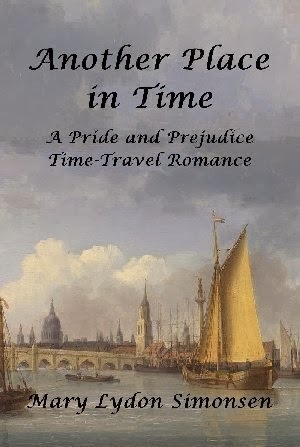 February 12 - I am the guest of Maria Grace at Random Bits of Fascination where time-traveler Christine O'Malley talks about her visit to 1812 London in the company of Miss Georgiana Darcy and Mr. Fitzwilliam Darcy in connection with the release of my time-travel novel, Another Place in Time.
February 12 - I am the guest of Maria Grace at Random Bits of Fascination where time-traveler Christine O'Malley talks about her visit to 1812 London in the company of Miss Georgiana Darcy and Mr. Fitzwilliam Darcy in connection with the release of my time-travel novel, Another Place in Time.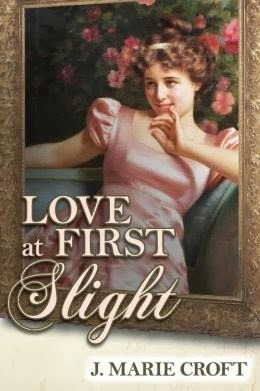
February 13 - Marie Croft joins me to share her wit and writing talent as she talks about her new release, Love at First Slight. Marie will be hosting a giveaway of one paperback copy and one e-book, open internationally, courtesy of Meryton Press.
February 18 - I am a guest of Jakki Leatherberry on Leatherbound Reviews where I will interview Mr. Darcy about his time in 2012 Baltimore. Yes, I got to meet Mr. Darcy! Lucky me!
Published on February 10, 2014 10:47
February 3, 2014
Interview with Time Traveler from Another Place in Time
 In my new time-travel romance,
Another Place in Time
, Mr. Darcy travels through time to meet with Chris O’Malley, an expert on the Regency Era and the novels of Jane Austen. I recently interviewed Chris to find out more of her thoughts on Mr. Fitzwilliam Darcy.
In my new time-travel romance,
Another Place in Time
, Mr. Darcy travels through time to meet with Chris O’Malley, an expert on the Regency Era and the novels of Jane Austen. I recently interviewed Chris to find out more of her thoughts on Mr. Fitzwilliam Darcy.Mary: Easy question. What was your first impression of Mr. Darcy when he showed up at the Baltimore Jane Austen conference in 2012?
Chris: Thanks, Mary, for having me on your blog. I feel like I already know you. To answer your question, please keep in mind that I saw the conference as an opportunity to increase my exposure in the Austen community, so when this “imposter” showed up and basically took over the session, I was not amused. What I remember thinking is that this guy is one hot dude—better than Colin—better than Matthew. But after I stopped admiring his assets, I was pretty steamed. When I spoke to him in the lobby, I thought this “actor” had Mr. Darcy’s arrogance down pat. It was all about him.
Mary: At first, you refused to help Mr. Darcy. What changed your mind?
Chris: I realized that this guy, whoever he was, was deeply in love with his Elizabeth Bennet. Because he was willing to ask for help in repairing the damage he had done when he had proposed marriage, I thought I might give him some advice. By showing some humility, he had already taken the first step.
Mary: When was your first inkling that this Mr. Darcy might be the genuine article?
Chris: Today, you practically get a smart phone at your kindergarten graduation, so when I watched Mr. Darcy using his iPhone, he reminded me of a kid in a candy store. He kept showing me all the things he could find by “Googling,” a word that delighted him. Another clue was that whenever a plane flew over, he would stop and look up in the sky until it was out of sight. Who does that now?
Mary: I think I would be nervous getting into a time capsule.
Chris: That’s because you’re smarter than I am. (Chris laughs.) The main reason I went back to 1812 was because the Regency Era is my area of expertise. I couldn't pass up a chance to see what London looked like during the Regency. Also, I was at a rather low point in my personal life. I think that was why I was willing to take the risk.
Mary: I understand that you will be talking about Regency London on Maria Grace’s blog. Is that correct?
Chris: Yes, I will. When I was in London, my guides through Town were Georgiana Darcy and Fitzwilliam Darcy. I look forward to sharing the experience with you.
Chris will be doing an interview on Random Bits of Fascination on February 12th. We hope to see you there.
Another Place in Time is available on Nook and Kindle. The paperback will be available in about two weeks.
Published on February 03, 2014 23:05
January 31, 2014
Launch of Another Place in Time
 January 30th was the official launch of my time-travel romance,
Another Place in Time
, on Austen Variations. As part of the celebration, there is a giveaway of one e-book and one paperback proof copy of the novel. The details are on the Austen Variations blog. You must comment by February 3rd to be eligible for the giveaway.
January 30th was the official launch of my time-travel romance,
Another Place in Time
, on Austen Variations. As part of the celebration, there is a giveaway of one e-book and one paperback proof copy of the novel. The details are on the Austen Variations blog. You must comment by February 3rd to be eligible for the giveaway.It is my plan to write some blog posts concerning the background and writing of Another Place in Time . Stay tuned. It's been a very busy time at Austen Variations.
Published on January 31, 2014 14:14
January 15, 2014
Book News
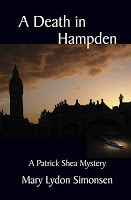 A Death in Hampden
, the third in the Patrick Shea mystery series, is on sale from 1/14 - 1/17 for $1.99 on Amazon Kindle. That is a $2.00 savings. You can find it at this link.
A Death in Hampden
, the third in the Patrick Shea mystery series, is on sale from 1/14 - 1/17 for $1.99 on Amazon Kindle. That is a $2.00 savings. You can find it at this link.My time-travel romance, Another Place in Time , will be launched on Austen Authors on January 30th. There will be a free e-book to celebrate the launch. Here is a summary from the back jacket:
In the time-travel romance, Another Place in Time, Fitzwilliam Darcy learns of the existence of Elizabeth Bennet from Hannah and Jacob Caswell, time travelers from the twenty-first century. When Darcy’s offer of marriage is rejected at Hunsford Parsonage, the Caswells advise Darcy to visit the future and seek the assistance of an expert on Jane Austen and the Regency Era.
When Darcy arrives in Baltimore in 2012, he finds Christine O’Malley serving on a panel at a Jane Austen conference. Although his arrival is a crowd pleaser, Chris is upset that an “actor” impersonating Mr. Darcy has stolen the show. After a rocky start, Chris agrees to go with Darcy to the past to help him sort out the mess with Elizabeth.
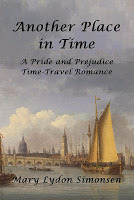
While plans are being made for Darcy to capture the heart and hand of Elizabeth Bennet, Chris, who has experienced her own heartache, finds she is falling for Darcy’s cousin, Colonel Fitzwilliam. With her sensibilities firmly rooted in the future, will Chris be able to find happiness with a man who occupies another place in time?
Published on January 15, 2014 08:41
December 24, 2013
Merry Christmas!
Published on December 24, 2013 16:54
December 18, 2013
The Boar's Head Carol
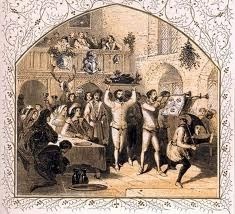 Queen's College, Oxford, celebrates the tradition of the Boar's Head Feast whereby three chefs bring a boar's head into hall, with a procession of a solo singer who sings the first verse, accompanied by torch bearers and followed by a choir. The procession stops during verses and walks during the chorus. The head is placed on the high table, and the Provost distributes the herbs to the choir and the orange from the Boar's mouth to the solo singer.William Henry Husk, Librarian to the Sacred Harmonic Society, wrote about the tradition in 1868 in his Songs of the Nativity Being Christmas Carols, Ancient and Modern:
Queen's College, Oxford, celebrates the tradition of the Boar's Head Feast whereby three chefs bring a boar's head into hall, with a procession of a solo singer who sings the first verse, accompanied by torch bearers and followed by a choir. The procession stops during verses and walks during the chorus. The head is placed on the high table, and the Provost distributes the herbs to the choir and the orange from the Boar's mouth to the solo singer.William Henry Husk, Librarian to the Sacred Harmonic Society, wrote about the tradition in 1868 in his Songs of the Nativity Being Christmas Carols, Ancient and Modern:Where an amusing tradition formerly current in Oxford concerning the boar's head custom, which represented that usage as a commemoration of an act of valour performed by a student of the college, who, while walking in the neighbouring forest of Shotover and reading Aristotle, was suddenly attacked by a wild boar. The furious beast came open-mouthed upon the youth, who, however, very courageously, and with a happy presence of mind, thrust the volume he was reading down the boar's throat, crying, "Græcum est," and fairly choked the savage with the sage. (Wikipedia)You can listen to the carol at this link.
Published on December 18, 2013 11:05
December 13, 2013
Darcy on the Hudson - Background and Research #6 - Background and Research
In
Darcy on the Hudson
, Mr. Darcy travels by sloop from Tarrytown to West Point. During his time on the river, one of the houses he would have passed would have been Clermont, home to the Livingston family, one of the oldest families in the Hudson River Valley.
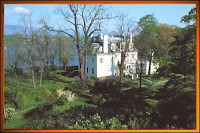 ClermontLife had been good to the Livingstons of Dutchess County (including Philip, a signer of the Declaration). From their manor house, the Robert Livingstons could view some of their half million acres of land acquired through patent and marriage. Robert R. Livingston (1718 – 1775, aka “The Judge”) added hundreds of thousands of acres to the family’s landholdings when he had married Margaret Beekman,* a formidable woman from one of the most prominent old Dutch families in the Hudson River Valley.
ClermontLife had been good to the Livingstons of Dutchess County (including Philip, a signer of the Declaration). From their manor house, the Robert Livingstons could view some of their half million acres of land acquired through patent and marriage. Robert R. Livingston (1718 – 1775, aka “The Judge”) added hundreds of thousands of acres to the family’s landholdings when he had married Margaret Beekman,* a formidable woman from one of the most prominent old Dutch families in the Hudson River Valley.
When Robert the Judge died in 1775, he left Margaret and their children to face the trials of the Revolution. Most dramatic was the burning of Clermont and its outbuildings on October 19, 1777 by British troops under the command of General John Vaughan, who was throwing a hissy fit because of the surrender of the British Armies by General Burgoyne at nearby Saratoga. Once Margaret was informed that General Vaughan had burnt Kingston across the Hudson, she hid the silver and other valuables in her garden fountain. Other possessions were loaded aboard carts, and Mrs. Livingston, her daughters, servants, and slaves fled. Robert was not at Clermont during this time, but he would return to his childhood home to find only the foundation and exterior walls remained.
"Nevertheless, his mother (Margaret Beekman) energetically went about the task of rebuilding Clermont upon its original foundation and on the same Georgian plan. In order to get workmen, she wrote to Governor George Clinton requesting that he exempt skilled tenants, masons, carpenters, plasterers, etc. from military service, and he agreed. By 1782 she was able to entertain General and Martha Washington in her new home, the British forever gone from the Hudson River Valley." (Taken from the official Clermont site)
The Livingstons are excellent examples of the conundrum one faces when writing about the heroes of the Revolution. Yes, they "pledged their lives, fortunes, and sacred honors," but many had set off on that path because they were protecting their fabulous wealth. (Remember: “No taxation without representation.”) The Livingstons wanted to be free of British tyranny, but kept slaves. And they kept their heels on the necks of their tenants and were disinclined to sell their property to anyone, causing anyone seeking a better life to move westward. During wartime, Margaret Beekman had asked and had received the release of able-bodied men from military service to rebuild her house. But the bottom line is that if the Americans had not succeeded in their quest for independence, their leaders, including the Livingstons and Beekmans, would have had their estates confiscated, and Robert would very likely have hanged. As Abraham Clark of New Jersey, a signer of the Declaration, put it, they would have “freedom or a halter.”
An aside: In the 1920's, the Commonwealth of Virginia wanted to present a statue of George Washington to the British people. There was one problem. After the War of Independence, George Washington had expressly stated that he wished never to stand on English soil. The good people of Virginia were in a quandary. Fortunately, someone came up with the idea of shipping a truckload of soil to England. Outside the National Gallery in Trafalgar Square, a hole was dug and filled with good Virginia dirt, and a statue of George Washington placed on top of it. With the possible exception of Washington, everyone was happy.
*The Beekmans appear in Darcy on the Hudson .
 ClermontLife had been good to the Livingstons of Dutchess County (including Philip, a signer of the Declaration). From their manor house, the Robert Livingstons could view some of their half million acres of land acquired through patent and marriage. Robert R. Livingston (1718 – 1775, aka “The Judge”) added hundreds of thousands of acres to the family’s landholdings when he had married Margaret Beekman,* a formidable woman from one of the most prominent old Dutch families in the Hudson River Valley.
ClermontLife had been good to the Livingstons of Dutchess County (including Philip, a signer of the Declaration). From their manor house, the Robert Livingstons could view some of their half million acres of land acquired through patent and marriage. Robert R. Livingston (1718 – 1775, aka “The Judge”) added hundreds of thousands of acres to the family’s landholdings when he had married Margaret Beekman,* a formidable woman from one of the most prominent old Dutch families in the Hudson River Valley.When Robert the Judge died in 1775, he left Margaret and their children to face the trials of the Revolution. Most dramatic was the burning of Clermont and its outbuildings on October 19, 1777 by British troops under the command of General John Vaughan, who was throwing a hissy fit because of the surrender of the British Armies by General Burgoyne at nearby Saratoga. Once Margaret was informed that General Vaughan had burnt Kingston across the Hudson, she hid the silver and other valuables in her garden fountain. Other possessions were loaded aboard carts, and Mrs. Livingston, her daughters, servants, and slaves fled. Robert was not at Clermont during this time, but he would return to his childhood home to find only the foundation and exterior walls remained.
"Nevertheless, his mother (Margaret Beekman) energetically went about the task of rebuilding Clermont upon its original foundation and on the same Georgian plan. In order to get workmen, she wrote to Governor George Clinton requesting that he exempt skilled tenants, masons, carpenters, plasterers, etc. from military service, and he agreed. By 1782 she was able to entertain General and Martha Washington in her new home, the British forever gone from the Hudson River Valley." (Taken from the official Clermont site)
The Livingstons are excellent examples of the conundrum one faces when writing about the heroes of the Revolution. Yes, they "pledged their lives, fortunes, and sacred honors," but many had set off on that path because they were protecting their fabulous wealth. (Remember: “No taxation without representation.”) The Livingstons wanted to be free of British tyranny, but kept slaves. And they kept their heels on the necks of their tenants and were disinclined to sell their property to anyone, causing anyone seeking a better life to move westward. During wartime, Margaret Beekman had asked and had received the release of able-bodied men from military service to rebuild her house. But the bottom line is that if the Americans had not succeeded in their quest for independence, their leaders, including the Livingstons and Beekmans, would have had their estates confiscated, and Robert would very likely have hanged. As Abraham Clark of New Jersey, a signer of the Declaration, put it, they would have “freedom or a halter.”
An aside: In the 1920's, the Commonwealth of Virginia wanted to present a statue of George Washington to the British people. There was one problem. After the War of Independence, George Washington had expressly stated that he wished never to stand on English soil. The good people of Virginia were in a quandary. Fortunately, someone came up with the idea of shipping a truckload of soil to England. Outside the National Gallery in Trafalgar Square, a hole was dug and filled with good Virginia dirt, and a statue of George Washington placed on top of it. With the possible exception of Washington, everyone was happy.
*The Beekmans appear in Darcy on the Hudson .
Published on December 13, 2013 17:08
November 27, 2013
Darcy on the Hudson - Background and Research #5 - West Point
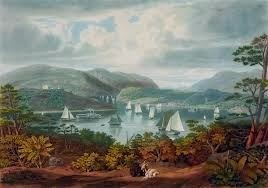 In
Darcy on the Hudson
, West Point cadet, Joshua Lucas (Charlotte’s brother) invites Georgiana Darcy to a formal ball at the academy. Of course, she must be accompanied by her brother. Originally, Jane and Elizabeth Bennet, as well as Charles Bingley, were to have made the journey thirty-five miles up the river from Tarryton. Instead, Darcy finds himself in the company of Caroline Bingley:
In
Darcy on the Hudson
, West Point cadet, Joshua Lucas (Charlotte’s brother) invites Georgiana Darcy to a formal ball at the academy. Of course, she must be accompanied by her brother. Originally, Jane and Elizabeth Bennet, as well as Charles Bingley, were to have made the journey thirty-five miles up the river from Tarryton. Instead, Darcy finds himself in the company of Caroline Bingley:Darcy stood on the deck as the sloop John Jay made its way through the Tappan Zee, the widest part of the Hudson, where wise sailors shorten sail. Small fishing boats shared the inland sea with schooners and barges carrying poultry, grain, and vegetables for the markets in New York while, nearby, dozens of sloops, with their single masts and retractable keels, negotiated around the shoals in the river.
As the hours passed, the sloop approached the Hudson Highlands, passing Anthony’s Nose and Breakneck Ridge. Farther up the Hudson, vast woodlands appeared with their leaves showing hints of the fall colors that would soon burst into a cornucopia of reds, yellows, and oranges that would ignite the hills from the Hudson to Appalachia in a blaze of color.
With the fortification now in view, Darcy immediately understood its importance to the British during the War of Rebellion. With its capture, the British would have control of the Hudson as New England would have been cut off from the rest of the colonies. But Darcy knew his history. In 1780, there were so few British troops in New York that capturing West Point by force of arms was impossible. It required intrigue and betrayal. If the gambit of having Benedict Arnold hand over West Point to the British had succeeded, the rebels would very likely have sued for peace. As he pondered the possibilities of what might have been, an enormous ridge came into view.
“If you are Dutch, the ridge is referred to as Boterberg,” Caroline explained as she came and stood beside Darcy, “but if you are English, it is Butter Hill, as it is supposed to look like a lump of butter.” Caroline had been watching Darcy as he wrote his notes and made detailed sketches in his journal. “Butter Hill is one of the wonders of the Hudson Highlands. However, I think it deserves a more dignified name, especially considering its proximity to West Point.”
“Yes, I agree. It merits a statelier name, and there are the stars and stripes of the American flag indicating we have arrived at West Point.”
After disembarking, the passengers were greeted by Joshua Lucas, who had assigned a junior cadet to be on the lookout for the John Jay. When he caught sight of Caroline, his eyes widened. Two years earlier, she had declared that she had attended her last military ball, and, yet, here she was. There could be only one reason: Caroline was on the prowl, and her prey was Fitzwilliam Darcy.
From Wikipedia: Although West Point cadets underwent training in artillery and engineering studies at the garrison since 1794, Congress did not formally authorized the establishment and funding of the United States Military Academy until 16 March 1802. In its tumultuous early years, the academy featured few standards for admission or length of study. Cadets ranged in age from 10 years to 37 years and attended between six months to six years. The impending War of 1812 caused the United States Congress to authorize a more formal system of education at the academy and increased the size of the Corps of Cadets to 250. The basis for the “Long Gray Line” expression originated in 1814 with the introduction of gray uniforms.
In 1817, Colonel Sylvanus Thayer became the Superintendent and established the curriculum still in use as of 2011. Thayer instilled strict disciplinary standards, set a standard course of academic study, and emphasized honorable conduct. Founded as a school of engineering, for the first half of the 19thcentury, USMA produced graduates who gained recognition for engineering the bulk of the nation's initial railway lines, bridges, harbors and roads. It was so successful in its engineering curriculum that it significantly influenced every American engineering school founded prior to the Civil War.
Published on November 27, 2013 13:22
November 23, 2013
Darcy on the Hudson - Background and Research #4 - Hindeloopen Folk Art
When traveling the Hudson River Valley, the Dutch influence can be seen in brick buildings with gambrel and stepped roofs, in the decorative arts in fireplaces and kitchens lined with Delft tiles, and heard in the words the Dutch left behind: crollers, cookies, gherkins, and cole slaw. But the Dutch also brought with them a distinctive style of folk art called Hindeloopen.
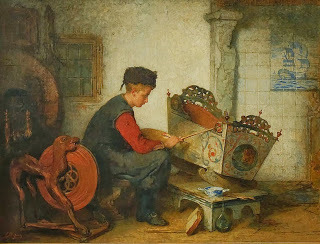 Charles Bisschop*According to
Dutch Proverbs
by Holly Flame Heusinkveld and Jean Carris-Osland, "Hindeloopen was a thriving seaport on the Zuider Zee in northwest Netherlands. During the Baroque and Rococo periods, guild and self-taught painters lavished their decoration skills on painted wood surfaces, such as furniture and walls, in an attempt to brighten home interiors and add inspiration to their surroundings. Hindeloopen villagers developed a distinct style of painting. Drawing from the scrolls of the Baroque period, the exotic birds of East Indian art, and the stylization of flower forms, the Hindeloopen painters came up with unique folk art forms. The objective was to fill a space, be it a table leg, door panel or storage chest, with flowers and berries or birds, in a stylized fashion."
Charles Bisschop*According to
Dutch Proverbs
by Holly Flame Heusinkveld and Jean Carris-Osland, "Hindeloopen was a thriving seaport on the Zuider Zee in northwest Netherlands. During the Baroque and Rococo periods, guild and self-taught painters lavished their decoration skills on painted wood surfaces, such as furniture and walls, in an attempt to brighten home interiors and add inspiration to their surroundings. Hindeloopen villagers developed a distinct style of painting. Drawing from the scrolls of the Baroque period, the exotic birds of East Indian art, and the stylization of flower forms, the Hindeloopen painters came up with unique folk art forms. The objective was to fill a space, be it a table leg, door panel or storage chest, with flowers and berries or birds, in a stylized fashion."
In an early draft of Darcy on the Hudson , Jane Bennet had painted a firescreen decorated in the Dutch folk art tradition that was greatly admired by Charles Bingley. It ended up being deleted, but I thought I would share the research.
*Christoffel Bisschop, Wiki Loves Art / NL project, organized by Wikimedia Nederland and Creative Commons Nederland.
Published on November 23, 2013 10:33
What readers are saying about The Second Date
I loved reading about the history of the families and how it was woven into the story. I felt right at home reading about Sonia and her family. It reminded me so much of my childhood growing up in the
I loved reading about the history of the families and how it was woven into the story. I felt right at home reading about Sonia and her family. It reminded me so much of my childhood growing up in the South and I found myself laughing out loud when reading about the one room no one was allowed to sit in with the plastic on the furniture and having to have a mediator at funerals. - C. Mason
Sonia Amundsen is a likable and feisty heroine, who is starting to think she isn't going to find her perfect man. It's not a predictable path to love and I really I loved the romance. The Second Date is an engaging picture of a close knit and vibrant group of friends and family in a community that has its share of fun, food, chaos and craziness. I found it a fascinating peek into the complexities and pressures of their lives and romances. It has depth and insight into the things in our pasts, our lives and families that make us who we are, with warmth, humour and realism. - Portia ...more
Sonia Amundsen is a likable and feisty heroine, who is starting to think she isn't going to find her perfect man. It's not a predictable path to love and I really I loved the romance. The Second Date is an engaging picture of a close knit and vibrant group of friends and family in a community that has its share of fun, food, chaos and craziness. I found it a fascinating peek into the complexities and pressures of their lives and romances. It has depth and insight into the things in our pasts, our lives and families that make us who we are, with warmth, humour and realism. - Portia ...more
- Mary Lydon Simonsen's profile
- 181 followers




